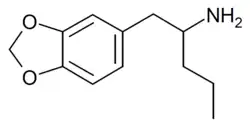1,3-Benzodioxolylpentanamine
 | |
| Clinical data | |
|---|---|
| Other names | 1-(3,4-Methylenedioxyphenyl)-2-aminopentane; 3,4-Methylenedioxy-α-propylphenethylamine; MDPPEA; α-Propyl-1,3-benzodioxole-5-ethanamine; α-Propyl-3,4-methylenedioxyphenethylamine; α-Pr-MDPEA; 2-Amino-1-(3,4-methylenedioxyphenyl)pentane |
| Identifiers | |
| |
| CAS Number | |
| PubChem CID | |
| ChemSpider | |
| Chemical and physical data | |
| Formula | C12H17NO2 |
| Molar mass | 207.273 g·mol−1 |
| 3D model (JSmol) | |
| |
| |
1,3-Benzodioxolylpentanamine (BDP), also known as K or as 3,4-methylenedioxy-α-propylphenethylamine (MDPPEA), is a drug of the phenethylamine and amphetamine families.[1][2][3] It is the parent compound of 1,3-benzodioxolyl-N-methylpentanamine (MBDP; methyl-K) and 1,3-benzodioxolyl-N-ethylpentanamine (EBDP; ethyl-K), as well as of pentylone (βk-MBDP).[1][2][3] The drug was synthesized by Alexander Shulgin and described in PiHKAL.[1] In contrast to MBDP and EBDP however, it is not known to have ever been tried by humans.[1][2] Very little is known about BDP.[1][2]
See also
References
- ^ a b c d e Shulgin AT, Shulgin A (1991). PiHKAL: A Chemical Love Story (1st ed.). Berkeley, CA: Transform Press. ISBN 9780963009609. OCLC 25627628.
- ^ a b c d Shulgin A, Manning T, Daley PF (2011). The Shulgin Index, Volume One: Psychedelic Phenethylamines and Related Compounds. Vol. 1. Berkeley: Transform Press. ISBN 978-0-9630096-3-0.
- ^ a b Trachsel D, Lehmann D, Enzensperger C (2013). Phenethylamine: von der Struktur zur Funktion [Phenethylamines: From Structure to Function]. Nachtschatten-Science (in German). Solothurn: Nachtschatten-Verlag. p. 556. ISBN 978-3-03788-700-4. OCLC 858805226. Retrieved 29 January 2025.
External links